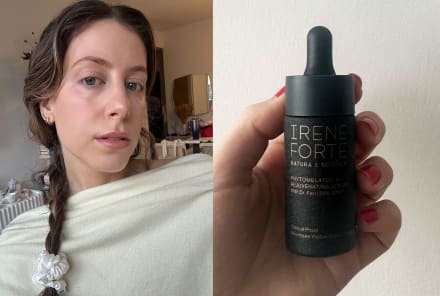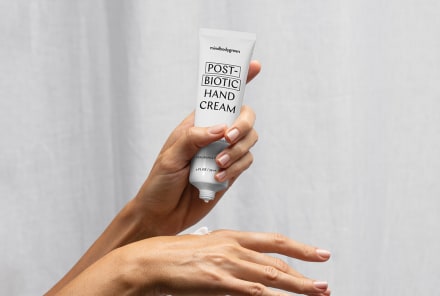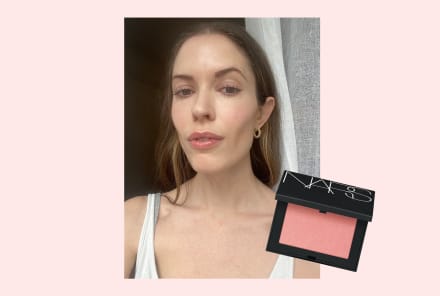Advertisement
What Causes Hair Static? Plus, 9 Hairstylist Tips To Get Rid Of Upright Strands

Frizz, static, flyaways—all are frustrating hair care woes in their own right. But hair static comes with some extra confusion, as it's a science-y little concept: What fires up those Einstein-level locks?
Wonder no more. Ahead, top hairstylists explain why your hair gets staticky and how to smooth down the upright strands.
What causes hair static?
Let's time-travel back to physics class: Static electricity happens when a surface receives extra electrons, which are negatively charged. So when certain materials rub against each other (like a knit hat against your hair), these negative charges hop onto the hair and start to build up. Objects with the same charge repel each other (think of magnets), which is the reason your hair stands on end—each strand is negatively charged, so they want to get as far away from each other as possible.
It tends to happen during colder months since dry, wintry conditions can exacerbate the static. "Electric charges don't flow through water, so atmospheres without any humidity will result in much more hair static," says hairstylist Miko Branch, co-founder of hair care brand Miss Jessie's. "Dry, damaged hair is more prone to static, as it lacks the moisture to repel electric charges."
Add some friction to an already dry environment (hats and scarves, vigorous brushing, towel-drying, etc.), and you can easily find yourself in a hair-raising situation.
How to prevent it.
Here's how to keep the hairs from standing up in the first place:
Use moisturizing shampoos and conditioners.
"Because dry hair is more prone to static, highly moisturizing shampoos and conditioners are essential prevention measures," says celebrity hairstylist Andrew Fitzsimons. It goes further than skipping sulfates (which are highly stripping of your scalp's natural oils and can turn strands brittle): Opt for shampoos that are rich in natural emollients, like oils and butters, and gentle surfactants. (If that sounds like a tall order, we have a pretty solid list here.)
An equally moisturizing conditioner can then help seal down the cuticle and add nutrients back to the strand. "Think of when you add softener to your clothes after washing them," hair expert and consultant Sarah Roberts says of the product category. Just as a softener can eliminate static cling from clothing, a conditioner lubricates the strands and makes them less likely to create friction as they rub against each other.
Use a hair mask regularly.
For extra moisture, especially during the dry winter months, a deep conditioning treatment is key. These are like three-course meals for your tresses, supplying the strands with nourishing oils, butters, and protein-rich ingredients. Slot in one of these hydrating hair masks weekly (or more often, depending on your level of dryness), or try your hand at a DIY treatment.
Swap your towel.
Traditional terry-cloth towels can roughen up the cuticle and cause friction on your strands, which can lead to increased hair static. "It has a sandpaper-like effect," hairstylist and founder of Hair Rules, Anthony Dickey once told mbg about towel-drying. Consider this your sign to invest in a soft microfiber cloth or use a T-shirt to remove excess water from the hair.
Ditch plastic combs.
"Metal combs conduct electricity, which helps remove electrical particles from your hair, whereas plastic combs can increase hair static," says Fitzsimons. Neat tip, no? You can also opt for combs made from wood or bamboo—just know that plastic is an insulator, which means it's a poor conductor of electricity (i.e., electric charges can easily build up on the surface).
On a similar detangling note, Fitzsimons also recommends using gentle strokes when brushing through your locks. A sound tip for general hair health, of course, but aggressive brushing can not only cause physical stress but more friction and static, too.
Sleep on silk.
Just like terry-cloth towels can lift the cuticle and cause more static and frizz, so can porous bedding fabrics like cotton or linen. And when you toss and turn, rubbing your strands against the pillowcase, that friction can certainly create some static come the a.m.
"Sleep with a silk or satin pillowcase, headscarf, or cap, which allows hair to slide as you toss and turn while sleeping. Silk and satin prevent friction (which leads to hair pulling, tugging, stretching, and tangling), and these smooth fabrics help retain the hair's natural oils," Branch says regarding the fabric. So the fabric doesn't just stop the friction that leads to static; it also helps keep the strands more moisturized, which can prevent the electric charge.
Invest in a humidifier.
Arid air exacerbates hair static, as it lacks the moisture and humidity needed to repel electric charges. Humidifiers add moisture back into the air, bringing your indoor levels back to an ideal range, which can keep your hair (and skin) happily hydrated. Find our best picks here, or check out these DIY options to combat dry air in the home.
How to get rid of it.
So you've pulled out all the stops this winter, only to find your hair standing upright before heading out the door. No fear: These quick tips will soften your mane.
Use an old dryer sheet.
"I always tell my clients to keep a dryer sheet handy, as rubbing your hair with it will eliminate static and immediately tame those pesky flyaway strands," Fitzsimons notes. We highly suggest making the swap to reusable wool dryer balls if you can, but this hack at least lets you squeeze some more use out of each sheet.
Smooth hairs with a leave-in.
A leave-in conditioner post-shower can infuse the strands with hydration and prevent static in the first place, but they're also great for slicking back flyaways in the moment. "Run a bit of leave-in conditioner through your strands to rehydrate and smooth the hair," Branch advises.
You could even use lotion in a pinch—just make sure it has hair-healthy ingredients like jojoba oil and shea butter). Many lotions contain overlapping ingredients to leave-ins and hair serums, anyway, so they can function similarly on the hair if you're in a bind.
Wet the strands.
"Another quick fix is to put some water on your fingers and smooth them over your hair to restore the positive and negative charge balance," says Fitzsimons. Again, electric charges don't flow through water, so a quick spritz can help lay down any pesky hairs.
The takeaway.
Hair static happens when your strands accumulate electrons from friction, which makes the strands repel each other and causes their standing ovation. As a general rule, keeping the hair hydrated is the key to preventing the static (since it's exacerbated by dry weather), but you can always smooth down the hairs in a pinch with these tips above.
Watch Next
Enjoy some of our favorite clips from classes
Enjoy some of our favorite clips from classes
What Is Meditation?
Mindfulness/Spirituality | Light Watkins
Box Breathing
Mindfulness/Spirituality | Gwen Dittmar
What Breathwork Can Address
Mindfulness/Spirituality | Gwen Dittmar
The 8 Limbs of Yoga - What is Asana?
Yoga | Caley Alyssa
Two Standing Postures to Open Up Tight Hips
Yoga | Caley Alyssa
How Plants Can Optimize Athletic Performance
Nutrition | Rich Roll
What to Eat Before a Workout
Nutrition | Rich Roll
How Ayurveda Helps Us Navigate Modern Life
Nutrition | Sahara Rose
Messages About Love & Relationships
Love & Relationships | Esther Perel
Love Languages
Love & Relationships | Esther Perel

















